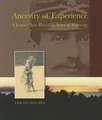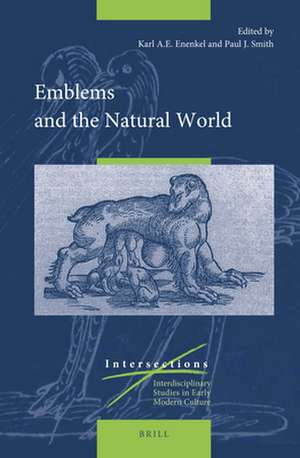Emblems and the Natural World: Intersections, cartea 50
Autor Karl A. E. Enenkel, Paul J. Smithen Limba Engleză Hardback – 20 sep 2017
Contributors: Alison Saunders, Anne Rolet, Marisa Bass, Bernhard Schirg, Maren Biederbick, Sabine Kalff, Christian Peters, Frederik Knegtel, Agnes Kusler, Aline Smeesters, Astrid Zenker, Tobias Bulang, Sonja Schreiner, Paul Smith, and Karl Enenkel.
Din seria Intersections
-
 Preț: 215.61 lei
Preț: 215.61 lei -
 Preț: 200.26 lei
Preț: 200.26 lei -
 Preț: 154.86 lei
Preț: 154.86 lei -
 Preț: 192.18 lei
Preț: 192.18 lei -
 Preț: 98.61 lei
Preț: 98.61 lei -
 Preț: 217.51 lei
Preț: 217.51 lei -
 Preț: 116.09 lei
Preț: 116.09 lei - 18%
 Preț: 1074.49 lei
Preț: 1074.49 lei -
 Preț: 241.64 lei
Preț: 241.64 lei -
 Preț: 241.64 lei
Preț: 241.64 lei -
 Preț: 228.96 lei
Preț: 228.96 lei -
 Preț: 229.55 lei
Preț: 229.55 lei -
 Preț: 241.64 lei
Preț: 241.64 lei -
 Preț: 226.67 lei
Preț: 226.67 lei -
 Preț: 107.21 lei
Preț: 107.21 lei -
 Preț: 208.79 lei
Preț: 208.79 lei -
 Preț: 201.78 lei
Preț: 201.78 lei -
 Preț: 226.85 lei
Preț: 226.85 lei -
 Preț: 225.71 lei
Preț: 225.71 lei -
 Preț: 246.63 lei
Preț: 246.63 lei -
 Preț: 228.96 lei
Preț: 228.96 lei - 47%
 Preț: 319.92 lei
Preț: 319.92 lei - 7%
 Preț: 315.66 lei
Preț: 315.66 lei -
 Preț: 96.10 lei
Preț: 96.10 lei - 18%
 Preț: 1201.75 lei
Preț: 1201.75 lei - 18%
 Preț: 659.69 lei
Preț: 659.69 lei - 18%
 Preț: 693.26 lei
Preț: 693.26 lei - 18%
 Preț: 1049.43 lei
Preț: 1049.43 lei - 18%
 Preț: 698.32 lei
Preț: 698.32 lei - 18%
 Preț: 681.99 lei
Preț: 681.99 lei - 18%
 Preț: 687.25 lei
Preț: 687.25 lei - 18%
 Preț: 820.59 lei
Preț: 820.59 lei - 18%
 Preț: 683.37 lei
Preț: 683.37 lei - 18%
 Preț: 667.86 lei
Preț: 667.86 lei
Preț: 1212.57 lei
Preț vechi: 1478.75 lei
-18% Nou
Puncte Express: 1819
Preț estimativ în valută:
232.03€ • 242.75$ • 192.74£
232.03€ • 242.75$ • 192.74£
Carte indisponibilă temporar
Doresc să fiu notificat când acest titlu va fi disponibil:
Se trimite...
Preluare comenzi: 021 569.72.76
Specificații
ISBN-13: 9789004347069
ISBN-10: 9004347062
Dimensiuni: 155 x 235 x 43 mm
Greutate: 1.27 kg
Editura: Brill
Colecția Brill
Seria Intersections
ISBN-10: 9004347062
Dimensiuni: 155 x 235 x 43 mm
Greutate: 1.27 kg
Editura: Brill
Colecția Brill
Seria Intersections
Cuprins
AcknowledgementsNotes on the EditorsNotes on the ContributorsList of Illustrations1 Introduction: Emblems and the Natural World (ca. 1530–1700)Karl Enenkel and Paul J. Smith
Part 1: Emblemetic Zoology—Zoological Emblem Books
2 “Natural” or “Unnatural”? Representation of the Animal World in Early French Emblem BooksAlison Saunders3 Camerarius’s Quadrupeds (1595): A Plinius Emblematicus as a Mirror of PrincesKarl Enenkel4 Joachim Camerarius’s Emblem Book on Birds (1596), with an Excursus on America’s Great SealPaul J. Smith5 Ichthyology and Emblematics in Conrad Gesner’s Historia piscium and Joachim Camerarius the Younger’s Symbola et EmblemataSophia Hendrikx6 The Daphnic Fate of Camerarius. Sweden’s First Printed Emblem Book Revealed in Olof Rudbeck the Younger’s Botanical Dissertation (1686)Bernhard Schirg7 Tradition and Empirical Observation—Nature in Giovio’s and Symeoni’s Dialogo Dell’ Imprese from 1574Maren C. BiederbickPart 2: Emblem Books on Physical Phenomena
8 Comets—Celestial Objects in the Emblem Tradition of the Late Seventeenth and Early Eighteenth CenturySabine Kalff9 Atmospheric Pressure: Natural Philosophy, Political Didactics and the Exigencies of Praise in Franz Reinzer’s Meteorologia Philosophico-Politica (1698)Christian PetersPart 3: The Applied Use of Natural Emblems, Especially in Monarchial and Courtly Contexts
10 Transcending the Natural World: A Developing Sublime in André Félibien’s Tapisseries du RoyFrederik Knegtel11 ‘Maiestatis Hungariae Aquila’: Christoph Lackner and the Hieroglyph of the Habsburg EagleAgnes Kusler12 The Secretion of a Pearl as a Symbol for the Birth of a PrinceAline Smeesters13 The Taming of the Lion: Passions, Power and Religion in Achille Bocchi’s Symbolicae Quaestiones (Bologna, 1555)Anne RoletPart 4: The Hermeneutic and Didactic Use of the Natural World
14 The Sagacity of Owls and the Mimetic Obscurity of Emblems in Joris Hoefnagel’s Four ElementsMarisa Anne Bass15 The Owl and the Birds: Speeches, Emblems, and FountainsAstrid Zenkert16 Hermeneutic Animals—Johann Fischart’s Use of Emblems in his German Translation of RabelaisTobias Bulang17 Orbis pictus For Boys—Emblematics for Men: Some Remarks on Learning by Studying Pictures and Interpreting RiddlesSonja SchreinerIndex NominumRecenzii
“Emblems and the Natural World is not simply a series of motif studies; instead, it offers the first major foray into what must become a vital subject of analysis for emblem scholars. […]. With its painstakingly researched essays and gorgeous and plentiful full-color illustrations, [it] will surely inspire new growth in the field of emblem studies and further research into the complex literary and artistic symbolism of the natural world.”
Deanna Smid, Brandon University. In: Renaissance Quarterly, Vol. 72, No. 1 (spring 2019), pp. 281-283.
“Emblems and the Natural World is a handsomely produced volume, laid out clearly, sturdy in the hand, and generously illustrated throughout, often in color, and with a crisp quality that throws up a pleasing degree of detail. […] this is a volume to be highly commended, full of interest, variety, depth of argument, and fresh insights into one of the defining territories of the early modern emblem: its dependence upon the rich abundance of the Liber naturae.”
Simon McKeown, Marlborough College. In: Emblematica, Vol. 2 (2018), pp. 371-378.
Deanna Smid, Brandon University. In: Renaissance Quarterly, Vol. 72, No. 1 (spring 2019), pp. 281-283.
“Emblems and the Natural World is a handsomely produced volume, laid out clearly, sturdy in the hand, and generously illustrated throughout, often in color, and with a crisp quality that throws up a pleasing degree of detail. […] this is a volume to be highly commended, full of interest, variety, depth of argument, and fresh insights into one of the defining territories of the early modern emblem: its dependence upon the rich abundance of the Liber naturae.”
Simon McKeown, Marlborough College. In: Emblematica, Vol. 2 (2018), pp. 371-378.
Notă biografică
Karl Enenkel is Professor of Medieval Latin and Neo-Latin at the University of Münster. Previously he was Professor of Neo-Latin at the University of Leiden. He has published widely on international Humanism, early modern culture, paratexts, literary genres 1300-1600, Neo-Latin emblems, word and image relationships, and the history of scholarship and science.
Paul J. Smith is Professor of French literature at Leiden University. He has widely published on 16th, 17th, and 20th century French literature, its reception in the Netherlands, French and Dutch fable and emblem books, literary rhetoric, intermediality, and animal symbolism and early modern zoology, and its presence in art and literature.
Paul J. Smith is Professor of French literature at Leiden University. He has widely published on 16th, 17th, and 20th century French literature, its reception in the Netherlands, French and Dutch fable and emblem books, literary rhetoric, intermediality, and animal symbolism and early modern zoology, and its presence in art and literature.
